Some links on this page are affiliate links. They may generate revenue for this site but there’s no extra cost to you if you make a purchase. More on affiliate links
Here are the 37 best things to do in Paris for tourists
Paris is the capital of France and an unforgettable city. The Eiffel Tower, Notre Dame Cathedral, Arc de Triomphe and Louvre Museum are must-see for first-time visitors. And there’s the broad avenue of Champs-Élysées, the most famous street in Paris.
There are more places to visit in Paris including famous monuments, palaces and museums. There are also charming neighbourhoods to explore. Not to mention some of the most scenic parks and gardens in France. And there’s the picturesque River Seine which Parisians have a romantic relationship.
The city offers plenty to see and do. To get you on the right start, here are the 37 most famous tourist spots in Paris. But don’t try to do them all in one visit. You don’t want to burn yourself out and spoil your trip. Prioritise and pick the ones that interest you the most. Then put them on your bucket list of top things to do in Paris.
YOU MAY ALSO LIKE
Famous Parisian Landmarks
Paris is home to many world-famous landmarks that visitors often associate with the city. These landmarks give the city its unique character. And a visit to Paris wouldn’t be complete without making a trip to see some of these famous icons. In fact, there are tons of landmarks but these are the top sites to visit in Paris for your bucket list.
The Eiffel Tower

- Location: Champ de Mars, 7th arrondissement
- Metro stations: Bir-Hakeim (Line 6), École Militaire (Line 8)
- See tickets and tours to the Eiffel Tower
The Eiffel Tower (La Tour Eiffel) is a colossal wrought-iron framework and ranks high on the bucket list for visitors. It’s the city’s most famous icon and is known around the world. Parisians nickname the tower the “La dame de fer”, meaning the Iron Lady. And no visit to the city is complete if you haven’t seen this grand monument.
The Eiffel Tower stands 330 metres (1,083 feet) tall. Opened in 1889, it was once the world’s tallest man-made structure until beaten in 1930 by the Chrysler Building in New York City. When it opened, many viewed the tower as a ugly pile of iron. Times have changed and Parisians now view the tower as a wonder of architecture.
The Eiffel Tower has 3 floors for visitors. The first at 57 metres (187 feet), the second at 115 metres (377 feet) and the top at 276 metres (906 feet). There are lifts (elevators) on three sides of the pillars to get up. If your legs are up to it, climb the stairs instead of the lift to the second floor. From the second floor to the top, you’d have to take the lifts.
The 360-degree view from the second and especially the top floor is engaging. Major sights include Grand Palais, Arc de Triomphe, La Défense and Montmartre. And there’s a glass floor on the first floor for an unnerving view below. Besides the views, there are some nice restaurants and gift shops on the first and second floors.
Trocadéro

- Location: Place du Trocadéro, 16th arrondissement
- Metro station: Trocadéro (Lines 6, 9)
The Trocadéro is on the other side of the River Seine from the Eiffel Tower. The area is a well-known and lovely part of the city. Highlights are Palais de Chaillot with its lovely architecture and Jardins du Trocadéro with its charming gardens. Behind the Trocadéro is Passy, a chic neighbourhood of trendy shops and restaurants.
Palais de Chaillot is a neo-classical building, separated into 2 wings and a broad plaza in front. From the plaza, you’ll get a striking view of the Eiffel Tower. Palais de Chaillot is also worth a visit to Cité de l’Architecture (architectural museum), Musée de la Marine (maritime museum) and Le Musée de l’Homme (anthropology museum).
In front of Palais de Chaillot is Jardins du Trocadéro, a lovely area of green space in the style of an English garden. The key feature is the Warsaw Fountains with its fountains in direct line with the Eiffel Tower. The visual effect is eye-catching with jets of water shooting as high as 50 metres (165 feet).
In summer, the lawns are popular places to relax and enjoy views of the Eiffel Tower. December is a special time at the Trocadéro when the Christmas Market opens with rows of small wooden huts selling gift items and tasty foods. On Bastille Day (14th July), this is one of the best spots to watch a dazzling show of fireworks.
Cathédrale Notre Dame de Paris

- Location: Île de la Cité
- Metro station: Cité (Line 4)
Cathédrale Notre Dame de Paris (Notre Dame Cathedral) is a 14th-century Catholic cathedral in honour of the Virgin Mary. The cathedral is on the small island of Île de la Cité (City Island), on the River Seine, where the history of Paris began. The building is intricate and a fine example of French Gothic architecture.
The cathedral is one of the most visited places in Paris. Unfortunately, a fire ravaged the building in 2019 and caused serious damage. Work is ongoing to restore the cathedral to its former glory and is expected to open in the spring of 2024. For now, you can only watch the cathedral from a distance.
The medieval cathedral is a Gothic masterpiece and a city icon. Construction began in 1163 and for the most part completed in 1269. There have been many modifications through the centuries. If you’ve read Victor Hugo’s famous (1831) novel “The Hunchback of Notre Dame”, this is the cathedral mentioned in the book.
There’s still plenty to admire even from the outside. It was the tallest building in Paris for centuries until replaced by the Eiffel Tower in 1889. The exterior features two lofty towers that soar 69 metres (226 feet) and spires that reach 90 metres (295 feet). The facades and carved portals are no doubt very detailed.
Sainte-Chapelle
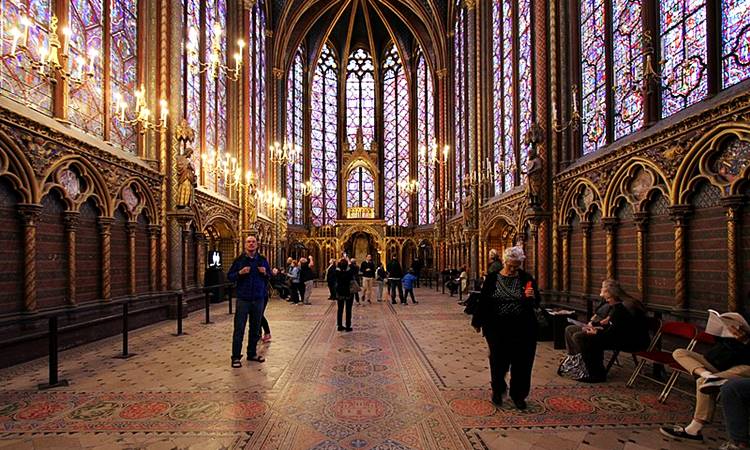
- Location: Île de la Cité
- Metro station: Cité (Line 4)
- See tickets and tours to Sainte-Chapelle
Sainte-Chapelle is a 13th-century royal chapel from the French Capetian dynasty. The chapel is also on Île de la Cité and a short walk from Cathédrale Notre Dame. And you’ll find it on the grounds of Palais de la Cité (City Palace), once home of the French kings until the 14th century. The palace is now the heart of the French justice system.
Completed in 1248, Sainte-Chapelle goes back to King Louis IX. During that time, the French king used the chapel to keep his sacred collections of Christian relics. And keeping these sacred relics ensured his powerful position. Today, the chapel is one of the earliest buildings from the Capetian dynasty that’s still around.
This Gothic gem is a unique historic site. After all, this is the finest royal chapel in France. The exterior features a 33-metre (108 feet) tall spire and is adorned with rose-coloured windows, sculptures and emblems. There’s an upper chapel used by the royals and a lower chapel for the non-royals serving the palace.
The interior is richly ornate. Most striking are the stained glass windows showing scenes from the Old and New Testaments. The windows are some of the finest and most extensive in the world. In fact, there are over 1,000! The upper chapel is almost entirely of stained glass windows. And a look up is a stunning view you’ll never forget.
Conciergerie

- Location: Île de la Cité
- Metro station: Cité (Line 4)
- See tickets and tours to the Conciergerie
Another historic site on Île de la Cité and near Sainte-Chapelle is the Conciergerie. It was once part of Palais de la Cité, the former royal palace. The 10th-century medieval palace was built during the reign of Hugh Capet, the King of the Franks. Future kings would later enlarge and modify the palace from the 11th until the 14th century.
The importance of the palace changed when King Charles V moved his residence to Hotel Saint-Pol and the Louvre Palace in the 1360s. The palace then took a judicial role and the Conciergerie turned into a prison. During the French Revolution, thousands including Marie Antoinette were imprisoned and tried here before being sent to the guillotine.
The Conciergerie is an interesting visit though light on artefacts. That said, visitors get an engaging interactive tablet. The device lets you see how the rooms and halls looked centuries ago as you scan around. There’s plenty of information and available in French, English, Spanish, German, Italian and Chinese.
Highlights include Salle des Gens d’Armes, a grand hall where the royal family dined and held their banquets. Salle des Gardes is a smaller hall where prisoners were accused and tried during the French Revolution. And there’s a recreation of Marie Antoinette’s cell where she was imprisoned before her execution.
Arc de Triomphe
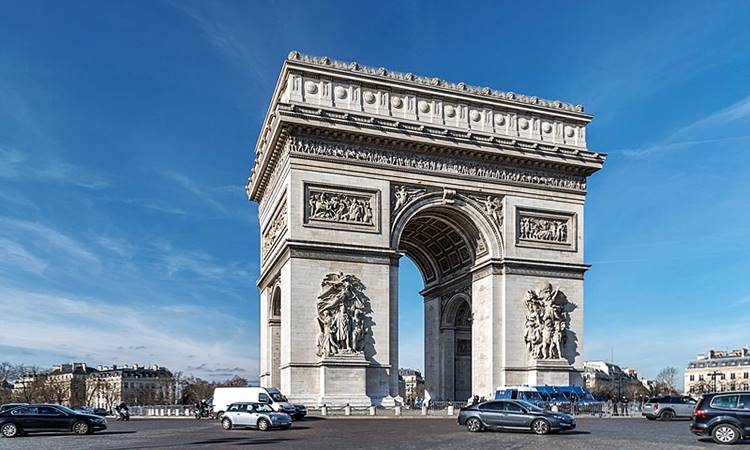
- Location: Place Charles de Gaulle, 8th arrondissement
- Metro stations: George V (Line 1), Kléber (Line 6), Ternes (Line 2)
- See tickets and tours to Arc de Triomphe
Arc de Triomphe (Triumphal Arch) is a striking national monument. Like the Eiffel Tower, the arch is another world-famous Paris icon. Built between 1806 and 1836, Arc de Triomphe initially paid tribute to Napoleon and his grand army. But the arch today pays tribute to those who fought and died for France.
Arc de Triomphe is a giant 50-metre (164 feet) tall arch in the middle of a busy roundabout. Twelve streets radiate from the roundabout including Avenue des Champs-Elysées. The area is racing with heavy traffic and too risky to cross. Instead, use the underpass leading to the arch and you’ll avoid the traffic.
You don’t need to pay to visit the open area at the ground level. Elaborate sculptures adorn the outer walls. And on the inner walls are the names of hundreds of French generals and soldiers who fought in the Napoleonic Wars. Beneath the arch is the Tomb of the Unknown Soldier from the First World War and an eternal flame.
Buy a ticket and climb nearly 300 steps to the top for a unique view of Paris – you could also take the lift (elevator). The best views are in the evenings when there’s a beautiful sunset. Inside, there’s a small museum telling about the history of the arch. Exhibits include models, photographs and multimedia screenings.
Avenue des Champs-Élysées
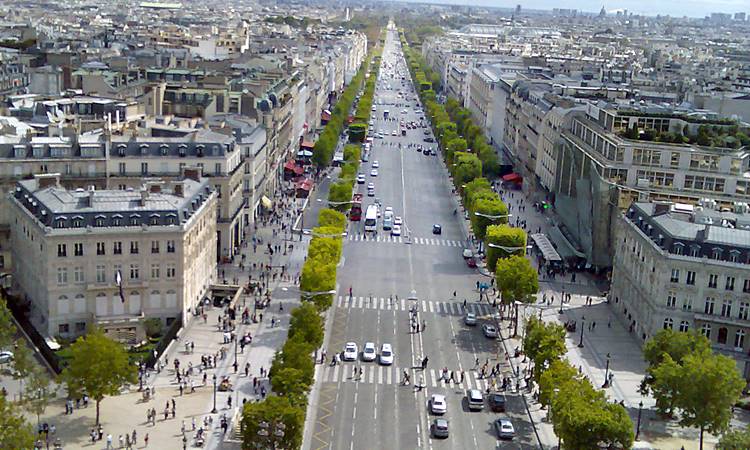
- Location: 8th arrondissement
- Metro stations: George V (Line 1), Franklin D. Roosevelt (Lines 1, 9), Champs-Élysées-Clemenceau (Lines 1, 13)
Avenue des Champs-Élysées is a broad stretch spanning 2 km (1.3 miles) between Arc de Triomphe and Place de la Concorde. This is the city’s most famous street and an exclusive stretch that many describe as one of if not the prettiest in the world. It’s a lovely street lined with trees and elegant Haussmann architecture.
The upper half of Champs-Élysées is a ritzy area of cafés, restaurants, entertainment spots, hotels and shops. There are plenty of great dining options if you’re willing to pay the prices. For film buffs, there are more cinemas here than any other street in Paris. What’s more, there are also theatres including the famous Théâtre du Rond-Point.
Champs-Élysées is a shopper’s heaven. As a matter of fact, the stretch is one of the most popular shopping streets in Paris. This prestigious location is filled with boutiques and flagship stores synonymous with luxury like Louis Vuitton, Dior, Cartier and Tiffany. But there are also less pricey options like Zara, Celio and Tara Jarmon.
The lower half of Champs-Élysées has a stately feel, away from the glitz and glamour. Here, you’ll meet up with the charming gardens of Jardins des Champs-Élysées. Nearby is Le Palais de L’Élysée, the official home of the French president. Not to miss out is Petit Palais, a museum with some of the finest art collections in Paris.
Place de la Concorde

- Location: Place de la Concorde, 8th arrondissement
- Metro station: Concorde (Lines 1, 8, 12)
Place de la Concorde is a historic square on the east end of Champs-Élysées. Octagon in shape, the square is the largest in Paris at nearly 8 hectares (19 acres). The square has a dark past! During the French Revolution, the site was the scene of 1,200 executions by guillotine including King Louis XVI and his wife Marie Antoinette.
The square was completed in 1772 in honour of King Louis XV. At the time, it was one of the most beautiful places in the city. The square was also the heart of the French Revolution in 1789. Today, it’s still one of the most beautiful squares in the French capital. Though at a busy road intersection, a visit is worth the time.
The focal point is a 3,000 years old obelisk from the Temple of Luxor in Egypt. The 23-metre (75 feet) granite pillar was a gift from the Viceroy of Egypt to King Charles X of France in 1830. The obelisk was erected in 1836 and written on the granite are hieroglyphics praising the Egyptian pharaoh Ramesses II.
Around the square are statues representing great French cities. There are also fountains north and south of the obelisk. And the fountain in the north is where King Louis XVI was guillotined! Completed in 1840, the fountains draw their design from the fountains in Rome. They are very elaborate with features of statues and figures.
Palais Garnier

- Location: Place de l’Opéra, 9th arrondissement
- Metro station: Opéra (Lines 3, 7, 8)
- See tickets and tours to Palais Garnier
Palais Garnier (aka Opera Garnier) is a grand opera house named after the architect Charles Garnier. When it opened in 1875, the 2,000-seat theatre was the world’s largest opera house but a costly affair. The theatre is the setting for Gaston Leroux’s 1910 novel and many stage and film adaptations of The Phantom of the Opera.
Palais Garnier is another Paris icon and plays an important role in French culture. Firstly, the theatre is an architectural gem of the 19th century. The style is Beaux-Arts with elements of Baroque and Renaissance designs. Secondly, the theatre is a major venue in Paris for many ballet and some opera performances.
The best way to admire the opera house is to attend a performance. Visitors who only want to see the grandeur of the theatre are also welcome – guided and unguided tours are available. Once inside you’ll be amazed by the lavish beauty all around. The interior’s design and artworks are astounding and worthy of a royal palace.
The corridors and galleries are adorned with chandeliers, paintings, carvings and frescos. The grand staircase is made from white marble while the railings from red and green marble. Paintings in the grand foyer depict moments in French music history. The auditorium has an intimate feel and features a painted ceiling with fine chandeliers.
Hôtel de Ville

- Location: Rue de Rivoli, 4th arrondissement
- Metro station: Hôtel de Ville (Line 1, 11)
Hôtel de Ville is the home of Paris City Hall and the office of the Paris Mayor. Built in the 16th century, this grand building has gone through expansions and renovations through the centuries. It was badly damaged during the Paris Commune uprising in 1871. Reconstruction began in 1873 but would take nearly 20 years to complete.
The exterior of the 3-floor building is exquisitely 16th-century French Renaissance. The features are elaborate with intricate facades and over 100 statues of prominent Parisians. Besides admiring from the outside, a guided tour of the interior is possible. A visit is by reservation only with the Protocol Department of Paris City Hall.
The tour is free and last about an hour. Guided tours are available in a number of languages including French, English and German. Unlike the exterior, the interior is 19th century with a big show of Beaux-Arts designs and deco. Murals, paintings, sculptures and fine chandeliers adorn the lavish interior.
Panthéon
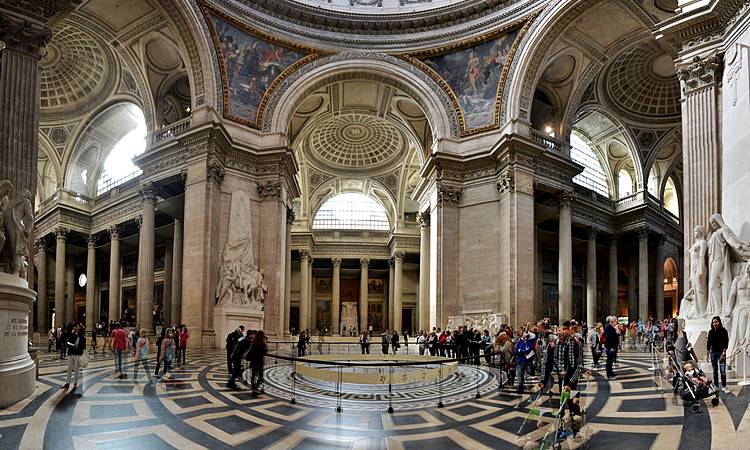
- Location: Place du Panthéon, 5th arrondissement
- Metro station: Cardinal Lemoine (Line 10)
- See tickets and tours to the Panthéon
The Panthéon is a majestic monument by the French architect Jacques-Germain Soufflot. He was inspired by the Pantheon in Rome, a former Roman temple converted into a Catholic church. More than that, Soufflot’s ambition was to outshine the churches of St Peter’s Basilica in Rome and St Paul’s Cathedral in London.
The history of the Panthéon began when King Louis XV commissioned the building of a church in honour of St Genevieve. But the plan changed during the French Revolution, which began in 1789. In time the National Assembly voted to turn the church into a mausoleum for prominent figures of the revolution and to be renamed the Panthéon.
The exterior is neoclassical with a mix of Classical Greek and Gothic designs. The most striking features are the richly decorated Corinthian columns, intricate sculptures on the pediment and a huge dome. And inside are the crypts of France’s eminent citizens including Jacques Rousseau, Voltaire, Jean Monnet, Victor Hugo and Marie Curie.
The interior is spacious with high ceilings and is very impressive. Beautiful paintings, sculptures, frescoes and carvings adorn the interior. Much of the art depicts scenes of key events in France’s history including the French Revolution. If your legs are willing, walk up to the top of the dome for panoramic views of Paris.
Les Invalides

- Location: Rue de Grenelle, 7th arrondissement
- Metro stations: Varenne (Line 13), La Tour – Maubourg (Line 8), Invalides (Lines 8, 13)
- See tickets and tours to Les Invalides
Les Invalides is a massive complex completed in 1676. It was initially a hospital and retirement home for France’s war veterans till the early 20th century. Today, Les Invalides honours the French military and its history. And within is a sprawl of museums, monuments and the burial site for many of France’s war heroes.
King Louis XIV, who was fond of the military, built Les Invalides for his wounded and retired soldiers. The complex represented the monarchy during the French Revolution and was set on fire. When Napoleon Bonaparte became the Emperor of France, he restored the complex back to its former glory in appreciation of the military.
The huge golden Église du Dôme crowning the main building is a very prominent sight. Under the dome are the tombs and vaults of France’s most famous military leaders. The most prominent of them all is the large raised tomb of Napoleon Bonaparte. The tomb is directly under the dome and laid to rest here in 1861.
Besides the tombs of France’s war heroes, there are also 3 interesting museums. A visit offers insights into French military history.
- Musée de l’Armée (Army Museum) – Filled with French military uniforms, weapons and other military artefacts from the distant past to the Second World War.
- Musée des Plans-Reliefs (Museum of Military Models) – See miniature models of cities and towns once used by the military from the 17th to 19th century.
- Musée d’Histoire Contemporaine (Museum of Contemporary History) – Explores issues in French and world history from the mid-19th century to the present.
Tour Montparnasse
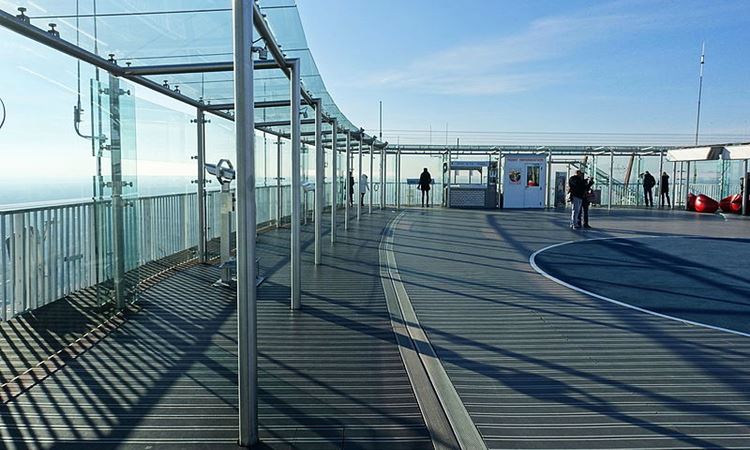
- Location: Avenue du Maine, Montparnasse, 14th arrondissement
- Metro station: Montparnasse – Bienvenüe (Lines 4, 6, 12, 13)
- See tickets and tours to Montparnasse Tower
Tour Montparnasse (Montparnasse Tower) stands 210 metres (689 feet) in the Montparnasse area of Paris. Completed in 1973, the office skyscraper was the tallest in France until overtaken by Tour First (in the La Défense business district) in 2011. At the foot is the Montparnasse Rive Gauche shopping centre, home to more than 50 outlets.
The skyscraper is simple in design and looks out of place with the city landscape, which has been a subject of controversy. That said, it’s a Parisian landmark. Besides the Eiffel Tower, Tour Montparnasse offers another splendid bird’s eye view of Paris. Ride up to the observation deck on the 56th floor and walk up to the rooftop deck on the 59th floor.
The view of the French capital from the decks is a breathtaking sight. On a clear day, you can see as far as 40 km (25 miles). Not to mention a splendid view of the Eiffel Tower in the distance and a pretty sunset if you come during the latter part of the day. There’s a nice café for a break and a souvenir shop on the 56th floor.
La Défense

- Location: Hauts-de-Seine
- Metro station: Esplanade de La Défense (Line 1)
La Défense is the largest business district in Europe. Though outside the city limits, it’s a stone’s throw from the French capital and reachable by Metro. The big draw is the sprawl of futuristic buildings which are a world apart from the 19th-century charm of downtown Paris. As a matter of fact, La Défense attracts 8 million visitors each year.
The district is a scene of sleek skyscrapers, condos and a modern shopping centre. In the middle of the landscape is a spacious esplanade. The district is home to over 70 buildings in various forms and styles, many are among the tallest in France. The tallest is Tour First at 231 metres (758 feet) followed by Tour Hekla at 220 metres (722 feet).
The main monument is the Arche de la Défense, a modern version of the Arc de Triomphe and twice the height at 110 metres (360 feet). Buy a ticket to the monument for views of scenic Paris from the rooftop. On the ground, more than 60 art sculptures and lovely pockets of greenery dot the landscape.
Westfield Les 4 Temps is a huge 4-floor shopping centre with more than 200 stores. Not only that, there are over 60 restaurants and a multi-screen cinema. The Christmas Market in La Défense is the biggest in the Paris area. More than 300 wooden chalets pack the market, selling a vast selection of Christmas treats and gifts.
Unusual Tourist Attractions
There are some unusual places to visit in Paris. You may not find such sights promoted as tourist attractions in other parts of the world but not in this city. So here are the most famous places in Paris that are beyond the typical tourist attractions. A word of advice, they are not for everyone!
Musée des Égouts de Paris

- Location: Place Habib Bourguiba, 7th arrondissement
- Metro station: Alma – Marceau (Line 9)
- See tickets to the Paris Sewer Museum
Musée des Égouts de Paris (Paris Sewer Museum) is an opportunity to explore the city below the ground if you don’t mind being inside a sewer tunnel. An odd tourist destination but these sewer tours have been going on since 1889. After all, the city has one of the most modern sewer systems in the world.
The museum opens from Tuesday to Sunday and is an experience for the curious to find out what it’s like beneath the city and inside a sewer. But a visit isn’t for the claustrophobic. The walk is 500 metres (550 yards) through a sewer. The place is poorly lit, damp and has a foul smell though not as bad as most would imagine.
The museum is more than just a walk through a damp sewer tunnel. There are interesting displays of models and machines telling about the history of sewers in Paris, which goes back to the 14th century. And also the current sewer system including treatment. Most of all, you’ll appreciate the important role that sewer workers play.
Les Catacombes de Paris

- Location: Avenue du Colonel Henri Rol-Tanguy, 14th arrondissement
- Metro stations: Denfert – Rochereau (Lines 4, 6), Mouton Duvernet (Line 4)
- See tickets and tours to the Catacombs of Paris
Les Catacombes de Paris (Catacombs of Paris) is a maze of tunnels holding skeletons of 6 million Parisians! In the 18th century, cemeteries were overflowing with no place left to bury the dead. City officials came up with a solution. Transfer the bones into the tunnels of abandoned quarries 20 metres (66 feet) below the city.
The bones were initially dumped into the tunnels. In 1810, the city decided to renovate the tunnels into a mausoleum. Meeting the dead “inside their graves” sounds bizarre but not in Paris. Since 1809, visitors have been visiting the dead in their tunnel crypts. It was a novelty back then. Today, thousands of visitors visit the catacombs each year.
It’s more than 100 steps down to reach the 1.5-km (1 mile) long tunnel. The skulls and bones are neatly arranged, some even in geometric patterns. There are also stone tablets with descriptions and comments. A visit to meet the dead is not for the vulnerable, claustrophobic and those with respiratory ailments.
Cimetière du Père Lachaise

- Location: Boulevard de Ménilmontant, 20th arrondissement
- Metro station: Père Lachaise (Lines 2, 3)
Cimetière du Père Lachaise is the largest and most famous cemetery in Paris. The burial ground (free to enter) is the most visited in France and probably anywhere in the world – nearly 4 million visitors each year. The burial ground is a prestigious site, the final resting place of many wealthy and famous people including celebrities.
The cemetery spans 44 hectares (110 acres) featuring cobbled alleys and 70,000 burial plots. It’s compact and looks more like a park filled with shrines. Most of the buried are French but there are foreign celebrities who died while in Paris. Notable names include Oscar Wilde, Yves Montand, Simone Signoret and Jim Morrison.
The tombs are in various forms and art styles. There are grand mausoleums, elaborate monuments, burial chambers, mini chapels and some are just simple headstones. More than 5,000 trees and varieties of plants fill the cemetery. The greenery gives the burial ground a graceful scene and a tranquil feel.
Famous Museums to Visit
Paris is home to more than 130 museums! And there’s a diversity including museums devoted to art, culture, history, natural history, science and technology, archaeology and architecture. There are even museums devoted to sex, romance and smoking. With so many museums you can visit, here are the top picks of the famous in Paris.
Musée du Louvre

- Location: Rue de Rivoli, 1st arrondissement
- Metro stations: Palais Royal – Musée du Louvre (Line 1), Pont Neuf (Line 7)
- See tickets and tours to Musée du Louvre
Musée du Louvre (Louvre Museum) is the most visited museum in France, attracting over 9 million visitors each year. It’s the world’s largest devoted to art. And home to the largest collection of paintings by European masters that goes as far back as the Middle Ages. For serious lovers of art, an entire day here wouldn’t be enough.
Musée du Louvre is housed in the grand Louvre Palace, once a royal residence between the 14th and 18th centuries. Today, the palace has a rich collection of more than 400,000 artworks but only 35,000 are on display at a time. Exhibits include not only paintings but also sculptures, drawings, art objects and archaeological finds.
Collections start from Ancient Egypt to the 19th century. Michelangelo, Rembrandt, Raphael and Reuben are among the European masters with their art on display. Not to miss is the famous Mona Lisa by Leonardo da Vinci. There’s also art from the Islamic world and ancient civilisations of Greece, Rome and Etrusca.
Centre Pompidou

- Location: Place Georges Pompidou, 4th arrondissement
- Metro stations: Rambuteau (Line 11), Hôtel de Ville (Line 1)
- See tickets and tours to Centre Pompidou
Centre Pompidou (Pompidou Centre) is a huge multi-cultural complex in a futuristic-looking building. Within the complex is a public library, a centre for music, a cinema and most of all Musée National d’Art Moderne (National Museum of Modern Art). The museum is the largest in Europe devoted to modern and contemporary art.
The museum is the second most visited in Paris, attracting over 5 million visitors each year. There are over 100,000 items in the collection, starting from the early 20th century to the present. With such vast numbers, exhibits change regularly to show the depth of the art. There are also temporary exhibits devoted to a single artist each year.
The modern art is in various styles including cubism, abstract, fauvism, conceptual, surrealism and even pop art. Exhibits include paintings, sculptures, drawings, photographs, prints and new media. Famous artists represented here include Matisse, Rousseau, Delaunay, Picasso, Kirchner, Pollock and Andy Warhol.
Musée d’Orsay

- Location: Rue de la Légion d’Honneur, 7th arrondissement
- Metro station: Assemblée Nationale (Line 12)
- See tickets and tours to Musée d’Orsay
Musée d’Orsay (Orsay Museum) is another modern art museum. While Musée National d’Art Moderne (Centre Pompidou) focuses on modern art from the early 20th century to the present, Musée d’Orsay is from the mid-19th to early 20th century. Besides, there’s an impressive collection of impressionist and expressionist art.
Musée d’Orsay is the third most visited museum in Paris, receiving over 3 million visitors each year. The museum is spread across 4 floors. And collections from the period are some of the finest in the world, many by French artists. Most of the artworks are paintings and sculptures but there are also photographs.
Leading masters with their art here include Matisse, Millet, Modigliani, Picasso and Rousseau. There’s also a noteworthy collection by Van Gogh, Monet, Pissarro, Renoir, Redon and Courbet. Among the famous paintings are the Self-portrait of Van Gogh, Dance in the Country by Renoir and The Gleaners by Millet.
Musée National d’Histoire Naturelle
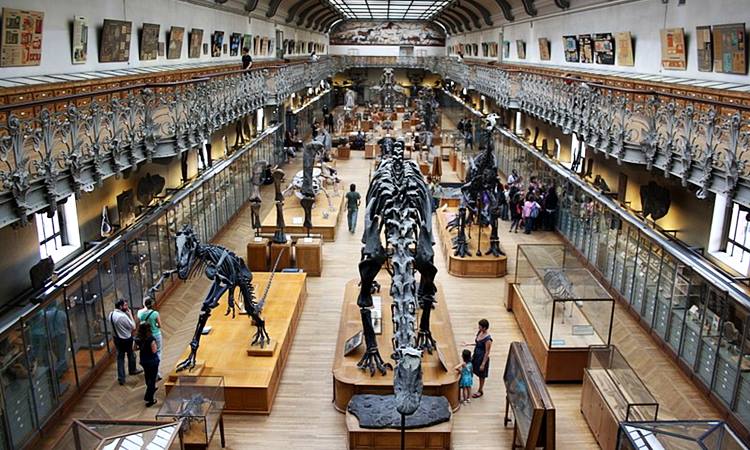
- Location: Rue Cuvier, 5th arrondissement
- Metro station: Austerlitz (Lines 5, 10)
- See tickets to Musée National d’Histoire Naturelle
Musée National d’Histoire Naturelle (National Natural History Museum) is a prestigious museum that goes back to 1793 during the French Revolution. The museum has 14 locations throughout France. The main and original site is in Paris, within the beautiful botanical garden of Jardin des Plantes.
There are several galleries, each in separate buildings. The best known is the Great Gallery of Evolution with more than 7,000 specimens including stuffed animals. You can’t miss the 2 giant whale skeletons and a giant squid on the ground floor. On the 1st floor is a parade of animals from the African savannah including zebras and cheetahs.
The Gallery of Paleontology and Comparative Anatomy has 650 or so skeletons including mammals, reptiles, fishes and birds. There’s a section devoted to dinosaur fossils and skeletons. The Gallery of Mineralogy and Geology has over 600,000 stones. Collections include giant crystals, treasured minerals and meteorites.
Cité des Sciences et de l’Industrie

- Location: Avenue Corentin Cariou,19th arrondissement
- Metro station: Porte de la Villette (Line 7)
- See tickets to Cité des Sciences et de l’Industrie
Cité des Sciences et de l’Industrie (City of Science and Industry) is the largest museum in Europe devoted to the world of science and technology. The museum is on the northeastern edge of the city, housed in a giant futuristic complex in Parc de la Villette. And there’s so much to see that a day wouldn’t be enough.
Young visitors will love the museum. After all, the aim is to promote interest in science and technology among the youth. There are amazing exhibits about the world of physics, energy, engineering, marine life, cosmology, space and transportation. What’s more, there are plenty of engaging interactive exhibits.
A top hit is the planetarium, exploring our solar system and galaxies in the distance. Another is the Argonaute, a French submarine from the 1950s that once sailed around the world 10 times. The Geode is a huge dome with a state-of-the-art Omnimax theatre screening science, nature and travel in high definition.
Musée du Quai Branly
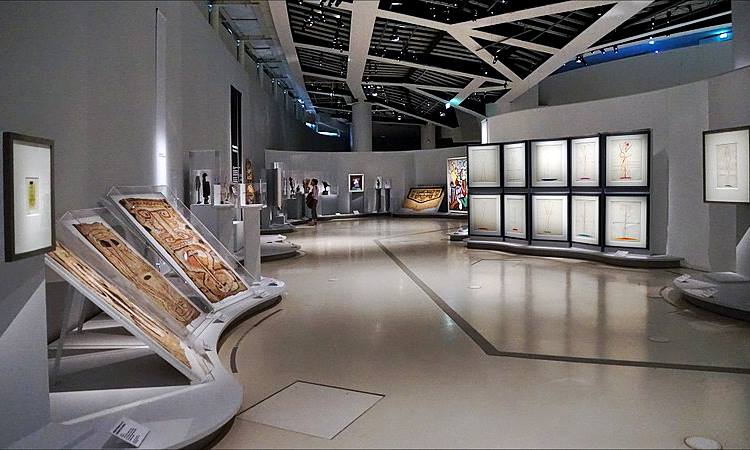
- Location: Quai Branly, 7th arrondissement
- RER station: Pont de l’Alma (Line C)
- See tickets and tours to Musée du Quai Branly
Musée du Quai Branly (Quai Branly Museum) opened in 2006 and pays tribute to non-European cultures. Exhibits are from Asia, the Middle East, Africa, the Americas and Oceania. There’s also a theatre for cultural performances. Though new compared to most museums in Paris, it’s certainly one of the most popular.
The museum has a large collection of more than 300,000 items and some date back centuries. For all that only 3,500 are on display at a time, rotating 500 each year. Displays are in 30 or so galleries and the largest is the main gallery, 200 metres (660 feet) long. There are also temporary exhibits tapping on various subjects and themes.
Exhibits include musical objects, paintings, costumes and textiles from non-European cultures around the world. Other items include intriguing sculptures, statues, masks, headdresses, religious and magical objects. There’s also a notable collection from the French colonisation of North America in the 17th and 18th centuries.
Musee de l’Orangerie

- Location: Jardin Tuileries, 1st arrondissement
- Metro station: Concorde (Lines 1, 8, 12), Tuileries (Line 1)
- See tickets and tours to Musee de l’Orangerie
Musee de l’Orangerie (Orange Museum) is not a museum devoted to oranges as the name sounds. But a modern art museum in a former shelter for nurturing orange trees during the cold winter. Opened in 1927, you’ll find an impressive collection of French modern art from the late 19th to early 20th century.
There’s a special focus on impressionist and post-impressionist paintings, a distinct French art style that developed between 1885 and 1905. There’s also a small collection of sculptures. Monet, Picasso, Rousseau, Renoir, Matisse and Utrillo are among the famous masters with their paintings displayed here.
The high spot is a painting by Monet titled The Water Lilies, comprising 8 large canvases which took 4 years to complete. The canvasses total 728 meters (2,389 feet) long and are displayed in 2 oval rooms. The paintings have a romantic feel and dream-like quality, featuring scenes from Monet’s garden at his home in Giverny.
Musée Picasso

- Location: Rue de Thorigny, 3rd arrondissement
- Metro station: St-Sébastien – Froissart (Line 8)
- See tickets and tours to Musée Picasso
Musée Picasso (Picasso Museum) has the largest collection of art by the famous Spanish artist Pablo Picasso. He was one of the most influential artists of the 20th century and lived in France from 1905 until his death in 1973. After his passing, the French government acquired his art and more after his widow’s death.
The museum is in a charming 17th-century mansion in Le Marais. While there are other museums hosting art by Picasso, Musée Picasso is the only one fully devoted to the artist. And there’s a rich collection of 5,000 including paintings, engravings, drawings, metals, ceramics and sculptures.
Picasso was a master of modern art and co-founder of the Cubist art style. He was also a man of many talents and one of the most prolific. Today, some of his paintings are worth millions. And Musée Picasso is a treasure trove of his art in various forms, styles and techniques developed through decades of his artistic career.
Petit Palais

- Location: Avenue Winston Churchill, 8th arrondissement
- Metro stations: Champs-Élysées – Clemenceau (Lines 1, 3)
Petit Palais (Small Palace) is across the street from the Grand Palais. This admiring Beaux-Arts building is home to the City of Paris Museum of Fine Arts. A small museum compared to others in Paris but you won’t be disappointed with the priceless treasures on display. Besides, Petit Palais is free to visit and enjoy.
The art here covers centuries. It’s not only paintings but also drawings, sculptures, tapestries, jewellery, metalwork, porcelain and icons. Showcases of paintings by European masters include Rembrandt, Rubens, Monet and Renoir. Other masters include Bertaux, Courbet, Pissarro and Cézanne.
Themed collections include the Middle Ages, Renaissance, 17th Century, 18th Century, 19th Century and Paris 1900. And these collections are very extensive. Others include the Classical World from ancient Greece and Rome. Icons features Greek, Byzantine and Russian religious objects from the 8th to 19th century.
Musée Grévin

- Location: Boulevard Montmarte, 9th arrondissement
- Metro stations: Grands Boulevards (Lines 8, 9)
- See tickets and tours to Musée Grévin
Musée Grévin (Grevin Museum) is a famous wax museum founded by Arthur Meyer. Opened in 1882, this is one of the oldest wax museums in Europe. And modelled after Madame Tussauds, the famous wax museum in London which opened earlier in 1835. Musée Grévin features over 250 wax models with new ones added regularly.
The wax models are famous people from the past and present including historic figures, film stars, musicians and sports celebrities. Notable figures in French history include King Louis XIV, Napoleon Bonaparte and General de Gaulle. Among the international figures are Albert Einstein, Mahatma Gandhi, Charlie Chaplin and Michael Jackson.
A visit to Musée Grévin begins with the Hall of Mirrors, a giant kaleidoscope that creates infinite images of the visitor. And there’s a panorama taking visitors through periods in French history. In one scene, there’s Jean-Paul Marat (a politician from the French Revolution) stabbed in his bathtub. In fact, it’s the real bathtub and knife!
Cruises on the River Seine
Boat tours on the River Seine are popular with many tourists in Paris. The cruises not only pass by many top sights in Paris but also offers a different view of the city. Board either the hop-on hop-off BatoBus or sightseeing cruises. Whichever you take, it’s a relaxing way to enjoy some of the best views of the city without the traffic.
Hop-on Hop-off BatoBus

- Boarding points: Any of the 9 BatoBus piers on the River Seine
- Metro station: Depends on the boarding point
- See tickets for hop-on hop-off BatoBus
The Batobus is a boat service on the River Seine that operates just like a hop-on hop-off tour bus. The boats stop at the BatoBus piers located near some of the city’s most famous attractions. Hop on at any BatoBus pier, enjoy the ride, hop off where you want, explore the sights and then return to the pier for the next boat coming your way.
These 180-seater boats sail in a loop stopping at 9 BatoBus piers. You can start and end your trip from any of the piers. Stops include near the Eiffel Tower, Les Invalides, Musée d’Orsay, Saint-Germain-des-Prés, Notre Dame Cathedral, Jardin des Plantes, Hôtel de Ville, Musée du Louvre and Place de la Concorde.
Passes valid for one day cost €19 and 2 days €21 for adults (half-price for kids). Hop on and off as many times as you like within the validity period. A round trip last about 2 hours with boats departing every 45 minutes on weekdays and 20-30 minutes on weekends. The BatoBus boats are glass covered with an open terrace for viewing.
Sightseeing River Cruises

- Boarding points: Several piers depending on the cruise
- Metro stations: Depends on the boarding point
- See tickets for cruises on the River Seine
There are also sightseeing cruises on the River Seine that don’t make any stops. Great if you want to sit back, relax and enjoy scenic views of the Parisian landscape without leaving the boat. Depending on your interest and of course your budget, there are plenty of choices for a river cruise in Paris.
There are non-stop 1-hour cruises that make circular trips. These popular cruises cost €16-17 for adults and half price for kids. They come with an audio guide available in several languages including French, English, German, Italian and Japanese. Boarding and return for most of these cruises are near the foot of the Eiffel Tower.
You can also travel in style and join one of the romantic dinner cruises. These cruises will set you back anywhere from €50 to €150 but a great experience. Take a seat, relax and admire the views while enjoying a meal prepared by some of the best restaurants in Paris. There are even dinner cruises entertaining you with live music.
Famous Parks in Paris
With so many absorbing sights you can easily forget Paris has some of the world’s prettiest parks and gardens. For visitors, parks in Paris are some of the best free things to do in Paris. They are not only marvellous green spaces but also places to unwind from the hustle and bustle of the French capital.
Jardin du Luxembourg

- Location: Boulevard Saint-Michel, 6th arrondissement
- Metro stations: Rennes (Line 12), St-Placide (Line 4)
Jardin du Luxembourg (Luxembourg Garden) boasts one of the prettiest parks in Paris. Spanning 25 hectares (62 acres), the history of the park goes back 400 years. And once owned by Marie de Medici, the widow of the French King Henry IV. Today, this famous park still retains the beauty of a royal garden.
At the heart is a French-style formal garden with geometric details created by flowerbeds and hedges. In the centre is a large octagonal pond, a popular spot for sailing model boats. Neatly arranged trees cover most of the area around the formal garden. And scattered across is a throng of fountains, monuments and statues.
At the north end is Palais du Luxembourg, once the royal residence of Marie de Medici. Completed in 1645, the palace is now home to the French Senate. In the northwest is the monumental Medici Fountain, built in 1630. This is one of the prettiest in Paris, featuring a long basin of water and surrounded by beautiful greenery.
There’s an orchard with varieties of apple and pear trees in the southwest corner. Nearby is an apiary where bees help to pollinate the flowers. Every September, the honey produced is sold at Fête du Miel (Honey Festival) at the Davioud Pavilion. What’s more are the greenhouses, home to decorative plants including exotic orchids.
Jardin des Plantes de Paris
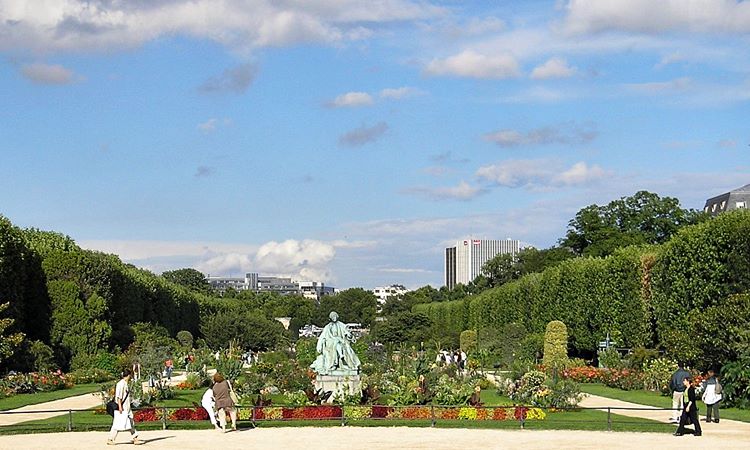
- Location: Rue Cuvier, 5th arrondissement
- Metro stations: Austerlitz (Lines 5, 10), Jussieu (Lines 7, 10), Place Monge (Line 7)
Jardin des Plantes de Paris (Paris Botanical Garden) is France’s main botanic garden. Opened in 1640, this charming green haven spans 28 ha (69 acres) on the southeastern edge of the Latin Quarter. Within the botanic garden, you’ll find the country’s national natural history museum and the oldest zoo in Paris.
The best time to come is spring and summer when flowers bloom in assorted colours. The arranged gardens are planted with pretty irises, jasmine, peonies, dahlias and roses – certainly lovely for a pleasant stroll. Don’t miss the 4 large greenhouses. Inside are all kinds of exotic plants from the tropical, desert and arid regions.
At the heart is the Alpine Garden, home to more than 2,000 highland plants from around the world. And there’s the Rose Garden featuring a rich variety of wild and contemporary roses. La Ménagerie is a small delightful zoo where small to medium-sized animals like orangutans, red pandas and snow leopards make their home.
Coulée Verte René-Dumont

- Location: Along Avenue Daumesnil, 12th arrondissement
- Metro stations: Ledru-Rollin (Line 8), Montgallet (Line 8)
Coulée Verte René-Dumont is not your typical park. The greenery sits on a former railway track above the ground between Opéra Bastille and Jardine de Reuilly, a small public park. It’s similar to High Line in New York City which spans 2.3 km (1.5 miles). But the one in Paris is twice the length at 4.7 km (2.9 miles) and is more elaborate.
The park above the ground passes the length of the 12th arrondissement. From Opéra Bastille, the stretch runs over the top of an old viaduct. Then continues through tunnels and open tracks. Besides the greenery, the walk offers amazing views from above the ground that you won’t get anywhere else in Paris.
This long and narrow stretch is a lush green oasis. There’s even a reflecting pool along the stretch. It’s a lovely landscape planted with all kinds of flowers, shrubs, vines, tall grasses and small trees such as lime and hazelnut. You’ll also find exotic bamboo plants. And some parts of the track are left wild to let nature grow on its own.
Bois de Vincennes

- Location: 12th arrondissement
- Metro station: Porte de Charenton (Line 8)
Bois de Vincennes (Vincennes Woods) is the largest park in Paris. At 995 ha (2,459 acres), this green lung is 7 times larger than Hyde Park in London and 3 times more than Central Park in New York City. Such a huge sprawl that you’d think you were in the quiet outback of France than the bustling capital of France.
Areas of woodlands span half of the park with woven trails to explore. There are also open fields of greenery with pockets of shady trees in between. At the four corners of the park are four charming lakes ringed by lush greenery. And some with islands where wild birds and fowls make their home.
Within is Parc Floral de Paris, a galore of pretty flowers including tulips, dahlias, azaleas and irises. Each year in summer, the floral park is the venue for the prestigious Paris Jazz Festival and it’s free to enjoy. Last but not least is Parc Zoologique de Paris, a medium-sized zoo with 3,000 animals living in 5 state-of-the-art biozones.
Bois de Boulogne

- Location: 16th arrondissement
- Metro station: Les Sablons (Line 1), Porte Dauphine (Line 2), Porte d’Auteuil (Line 10)
Bois de Boulogne (Boulogne Woods) is another huge green lung. The park was once a royal hunting ground for the French kings until turned into a public park in 1852. At 845 ha (2,088 acres), Bois de Boulogne is smaller than Bois de Vincennes but still larger than London’s Hyde Park and New York City’s Central Park.
The park is a charming scene of grasslands, woodlands, streams, lakes and ponds. There are also trails for lovely strolls. At the heart is Parc de Bagatelle with its formal garden boasting roses, irises, clematises, peonies and a pond filled with water lilies. Not to mention grottoes, streams, small murmuring waterfalls.
South of the park is Jardin des Serres d’Auteuil, home to 5 greenhouses with thousands of plants including palm trees, pineapples and cacti. And there’s Château de Bagatelle, a small mansion with several charming French gardens and a rose garden. In the north is Jardin d’Acclimatation, a popular amusement park for kids.
Bois de Boulogne even has a 7-hectare (17 acres) camp ground. All the cottages and caravans have a kitchenette, TV and private bathroom. There’s also a site for tents. Amenities include a grocery store and restaurant that opens for breakfast and dinner. There’s also a shuttle bus service that takes camp guests to and from the Metro station.
Best Fun Things to Do
Paris has plenty to enjoy with the kids. The Eiffel Tower and cruises on the River Seine are some great family attractions that kids would love. But planning a trip with the young ones can be tricky. They want a bit more fun. Without further ado, here are the best fun things to do in Paris for the kids.
Jardin d’Acclimatation

- Location: Bois de Boulogne, 16th arrondissement
- Metro station: Les Sablons (Line 1)
- See entry tickets to Jardin d’Acclimatation
Jardin d’Acclimatation is a popular amusement park for children. Covering 19 hectares (47 acres), the park is in the northwest corner of the Bois de Boulogne. Opened in 1860, Jardin d’Acclimatation initially began as a zoo but is now a fun place for young visitors and adults. And there’s plenty to enjoy that a day wouldn’t be enough.
The amusement park opens all year and offers nearly 50 activities. There are all sorts of mini roller coasters, water rides, carousels, swing rides and a mini train ride. Games include a shooting gallery, duck fishing and dart stand. And there’s a mini golf course and a puppet theatre that young kids would love.
There are beautiful gardens too including the Korean Garden where you can enjoy boating on the lake. Also, meet the alpacas in their enclosure at the Alpine Rock. Not to mention a community of farm animals at the Saint-Hilaire Farm. And there’s the Great Aviary, home to 150 birds from around the world including exotic species.
Aquaboulevard Water Park

- Location: Rue Louis Armand, 15th arrondissement
- Metro stations: Balard (Line 8), Corentin Celton (Line 12)
- See entry tickets to Aquaboulevard Water Park
Aquaboulevard spans 7,000 sq metres (75,000 sq feet) and is the largest urban water park in Europe. The outdoor area only opens during the warmer months. That said, the indoor section opens all year with the temperature kept comfortable at 29°C (84°F). So, come any time of the year to Aquaboulevard.
The indoor area has a beautiful tropical setting of palm trees and ferns. The outdoor section has a “beach” complete with sand, beach huts and sun decks. Highlights include the giant water slides, wave pools, wake box, waterfalls, water cannons and a lazy river. There are also jacuzzies to unwind and relax.
Feeling hungry? There’s always McDonald’s, McCafé and Häagen-Dazs. If you don’t have swimwear, you can buy from the onsite shops but prices are pricey. Don’t forget to bring a 1-euro coin to keep your personal stuff in the locker. Besides the fun in the water, Aquaboulevard has a multi-screen cinema showing the latest films.
Aquarium de Paris

- Location: Avenue Albert de Mun, Trocadéro, 16th arrondissement
- Metro station: Trocadéro (Lines 6, 9)
- See entry tickets to Aquarium de Paris
Aquarium de Paris is across the River Seine from the Eiffel Tower in the gardens of the Trocadéro. With around 60 tanks and pools to explore, the aquarium is a great place to learn about the underwater world. Making their home here are more than 10,000 creatures from the waters of France to the deeps of the Pacific Ocean.
Creatures from the waters include sharks, moray eels, sting rays, piranhas, octopuses, jellyfish and corals to name a few. The top attraction is the shark pool with a huge glass tunnel for close views of these amazing sea creatures. Another is the Médusarium, home to thousands of colourful species of jellyfish living in several tanks.
Kids will surely love the petting pool where they can feed and touch the carp. There’s also a small 2-screen cinema to watch absorbing documentaries and entertaining cartoons about the underwater world. Yes, you can take photos and videos at the aquarium for personal use but no flash or selfie sticks.
Where to Stay in Paris

There are plenty of good locations in Paris for visitors to stay. Then again, Paris is a big city and you’d want to stay where many of the attractions are. You also want a location with good transport links to get you around the city. Here are some suggested locations and you’ll find a wide range of accommodations.
- 1st Arrondissement – mostly high-priced 3 to 5-star hotels
- Le Marais (4th Arr) – mostly 3 to 5-star hotels
- Latin Quarter (5th and 6th Arr) – mostly 3 and 4-star hotels
- St-Germain-des-Prés (6th Arr) – mostly 3 and 4-star hotels
- 8th Arrondissement – mostly 3 to 5-star hotels
- 9th Arrondissement – mostly cheaper 3 and 4-star hotels
- 11th Arrondissement – a mix of budget, 3-star and cheaper 4-star hotels
- 12th Arrondissement – a mix of budget, 3-star and cheaper 4–star hotels
- Montparnasse (14th Arr) – a mix of budget, 3-star and cheaper 4-star hotels
- Batignolles (17th Arr) – a mix of budget, 3-star and cheaper 4-star hotels
- Montmartre (18th Arr) – a mix of budget, 3-star and cheaper 4-star hotels
Still not sure where to stay in Paris? Here are some suggested accommodations. It includes a mix of budget (1 and 2 stars), mid-range (3 stars) and upscale (4 and 5 stars) hotels to meet every travel budget and style.
Budget-Priced (1 & 2 ⭐)
Auberge Internationale Des Jeunes
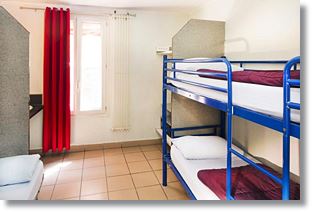
Bastille Hostel

Bastille Hostel (11th Arr) – Another hostel in Bastille and also near Ledru-Rollin Metro Station. There are no dormitories, only rooms for 1 and 2 people. All have a private shower, closet, table and electronic safe. There’s a drink machine and microwave in the common room. The hostel offers free breakfast.
Hôtel Exelmans

Hôtel Exelmans (16th Arr) – This budget hotel is a short walk from the River Seine and Exelmans Metro Station. Bookings include twin, double, family rooms and one-bedroom apartments. An airport shuttle service is available for a fee. The hotel has a restaurant and offers free breakfast.
Hôtel Résidence De Bruxelles

Hôtel Résidence De Bruxelles (18th Arr) – The property is a short walk from Gare du Nord (railway station). It’s also close to Montmartre and several metro stations. Rooms are basic but comfortable with private bathroom, TV and free WiFi. Hotel amenities include a coffee shop, TV lounge and luggage storage.
Mid-Range Hotels (3 ⭐)
Museum View Apartments
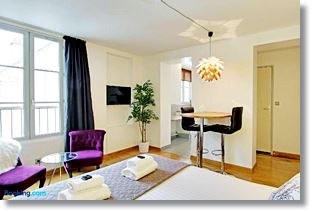
Museum View Apartments (5th Arr) – The service apartment is next to the famous Jardin des Plantes (botanical garden). Units include studios and one-bedroom apartments. They are modern and stylish with comfortable furnishing. Each unit has a fully equipped kitchen and dining table. The hotel has free WiFi.
Sure Hotel by Best Western

Sure Hotel by Best Western (10th Arr) – The hotel is a few minutes walk from Gare du Nord (railway station) and several Metro stations. Rooms are modern, comfortable and equipped with a range of amenities. Facilities include luggage storage and concierge service. The hotel serves a nice buffet breakfast.
Modern’s Hotel

Modern’s Hotel (12th Arr) – The property is near Gare de Lyon (railway station) and a few minutes walk from Canal Saint-Martin and the River Seine. Rooms are simple with modern furnishing. Luggage storage and currency exchange service is available. The hotel serves a buffet breakfast every morning.
Hôtel Marena

Hôtel Marena (9th Arr) – This hotel is conveniently located nearby shops, cafés and restaurants. Rooms include twin, double and triple. All have a private bathroom, TV, USB charger and reading lights. Late check-out (subject to availability) and buffet breakfast are available for extra charges.
Hôtel Migny Opera Montmartre

Hôtel Migny Opera Montmartre (9th Arr) – The hotel is nearby Pigalle Metro Station and a short walk from the attractions in Montmartre. Rooms are modern with warm colours and spacious compared to many hotels in Paris. All have private bathrooms, air-conditioning, mini-fridge, TV, tea/coffee maker and free WiFi.
Hôtel Waldorf Montparnasse

Hôtel Waldorf Montparnasse (14th Arr) – The property is a stone’s throw from Montparnasse Tower and nearby several Metro stations. Rooms are cosy and modern with a classic twist. Concierge services include taxi calls, restaurant bookings and tickets for shows. Breakfast is available for an extra fee.
Hôtel Du Mont Dore

Hôtel Du Mont Dore (17th Arr) – Located in Batignolles and within a short walk from Rome and Place de Clichy Metro Stations. The hotel is surrounded by numerous cafés and restaurants. Accommodations include standard and superior. Rooms are bright, soundproof and comfortable. Breakfast is served daily for a fee.
Upscale Hotels (4 & 5 ⭐)
Hôtel de Ville Apartments

Hôtel de Ville Apartments (4th Arr) – The hotel is centrally located and nearby several top tourist spots including Centre Pompidou and Notre Dame Cathedral. Accommodations include 1-bedroom apartments and studios, complete with private bathroom, kitchenette, living room, TV, ironing board and free WiFi.
Maison Albar Hotels Le Diamond

Maison Albar Hotels Le Diamond (8th Arr) – This luxury hotel is within minutes from dining and shopping on Boulevard Haussmann. Accommodations include luxurious rooms and suites featuring elegant furnishing. Breakfast is served daily in the dining room. The hotel has a charming terrace garden.
Best Western Opera Faubourg

Best Western Opera Faubourg (9th Arr) – The property is centrally located and a short walk from the famous Printemps and Galeries Lafayette department stores. Rooms are contemporary, chic and equipped with modern amenities including free WiFi. The hotel has a concierge service and luggage storage facility.
Maison Breguet
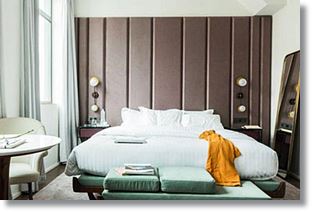
Maison Breguet (11th Arr) – Located in a quiet location near Le Marais, a historic and cultural quarter of Paris. The rooms and suites are modern, spacious and elegant with a beautiful décor. The hotel has an indoor heated pool, fitness centre, sauna, steam room and a lovely restaurant with a charming terrace.
Best Western Bretange Montparnasse

Best Western Bretange Montparnasse (14th Arr) – In a nice part of Montparnasse and well located near shops, cafés, restaurants and Metro stations. The rooms have been fully renovated and equipped with a range of amenities. Buffet breakfast is served in the breakfast room every morning.
Hôtel de Neuville

Hôtel de Neuville (17th Arr) – The hotel is a former 19th-century mansion. The soundproof rooms are contemporary with modern classic décor. You can enjoy a buffet breakfast in the breakfast room or a continental breakfast for room service. An airport shuttle service is available for an extra charge.
